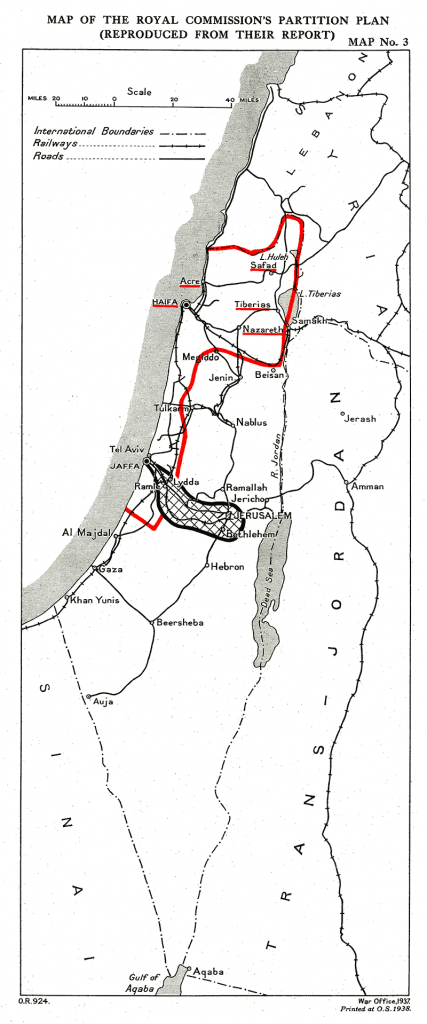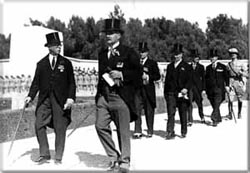 Continuing the series from Nur Masalha’s Expulsion of the Palestinians. . . .
Continuing the series from Nur Masalha’s Expulsion of the Palestinians. . . .
The Peel Commission released its report in July 1937 with British Government support. The Peel recommendations were to be the blueprint for future British policy in Palestine and opened the road towards a State (not just land) for the Jews. The commission declared that
- the national aspirations of the Arabs and Jews were irreconcilable
- An irrepressible conflict has arisen between two national communities within the narrow bounds of one small country. There is no common ground between them. Their national aspirations are incompatible. The Arabs desire to revive the traditions of the Arab golden age. The Jews desire to show what they can achieve when restored to the land in which the Jewish nation was born. Neither of the two national ideals permits of combination in the service of a single State.
- Palestine should be partitioned so that an Arab state was made up of Transjordan and the Arab part of Palestine and the rest a Jewish state
- If Partition is to be effective in promoting a final settlement it must mean more than drawing a frontier and establishing two States. Sooner or later there should be a transfer of land and, as far as possible, an exchange of population.
- the Jewish state would consist of one third of the including the most fertile regions, including the plain of Esdraelon, most of the coastal plain and the wholly Arab owned Galilee (Jewish population was 5.6% of the total at the time);
- the British would retain a corridor from Jerusalem to the coast;
- the Arab state would make up the rest, including the Negev desert;
- there would be an “exchange” of populations: 225,000 Arabs in the Jewish areas would “exchange” places with 1250 Jews — as a last resort this would be a “compulsory” move; this did not include the Arabs in Galilee — it was imagined that the Galilean Arabs would be encouraged to move voluntarily.
The full text of the report can be read online. (It’s an interesting read. It affirms the main themes this series of posts has been highlighting, especially the substantial and long-term Arab attachment to the land and their political aspirations in the wake of World War I.) I quote here its reference to the status of the Galilee because I find it especially interesting in what it tells us about long-term Jew-Arab relations prior to the dramatic changes from the 1920s onwards and the way the language of the report avoids the obvious implications for the future of an inevitable change of ownership and demographic shift (my bolding):
The proposed frontier necessitates the inclusion in the Jewish Area of the Galilee highlands between Safad and the Plain of Acre. This is the part of Palestine in which the Jews have retained a foothold almost if not entirely without a break from the beginning of the Diaspora to the present day, and the sentiment of all Jewry is deeply attached to the “holy cities” of Safad and Tiberias. Until quite recently, moreover the Jews in Galilee have lived on friendly terms with their Arab neighbours; and throughout the series of disturbances the fellaheen of Galilee have shown themselves less amenable to political incitement than those of Samaria and Judaea where the centres of Arab nationalism are located. At the “mixed” towns of Tiberias, Safad, Haifa, and Acre there have been varying degrees of friction since the “disturbances” of last year. It would greatly promote the successful operation of Partition in its early stages, and in particular help to ensure the execution of the Treaty guarantees for the protection of minorities, if those four towns were kept for a period under Mandatory administration.

Arab response to the report
Outrage. Violence, especially among the peasantry.

Zionist response to the report
The report gave the Zionists two key goals they had long been seeking:
- Assurance that a Jewish Homeland (as offered by the Balfour Declaration) would translate into a Jewish State;
- Approval for the transfer of the Arab population from that state.
As we saw in previous posts these are the two goals Zionist leaders (Weizmann, Shertok, Ben-Gurion) had been lobbying and working towards so hard for so long. But prudence remained important. It would not look good to be seen to be rejoicing too enthusiastically over the promise to transfer the Arab population from their areas.
Thus the Jewish Agency, of which Ben-Gurion was chairman, simultaneously attacked the partition plan in public as a breach of the Balfour Declaration promises (on the grounds that the Balfour Declaration had promised a Jewish home in all of Palestine), while privately seeking to negotiate with the British government for a Jewish state based on more advantageous positions. (p. 62)
In 1918 Ben-Gurion had called for a Jewish state that extended from the Litani River in the north to the Wadi Arish in the south and the Syrian desert as far as the farthest border of Transjordan in the east.
Weizmann made it clear to the British High Commissioner that the Jewish State borders being proposed by the Peel Commission were only temporary:
We shall expand in the whole country in the course of time. . . this is only an arrangement for the next 25 to 30 years. (Weizmann in a private conversation with the High Commissioner, A. Wauchope, 14 March 1937. Cited in Moshe Sharett, Yoman Medini, Vol. 2, p. 67)
